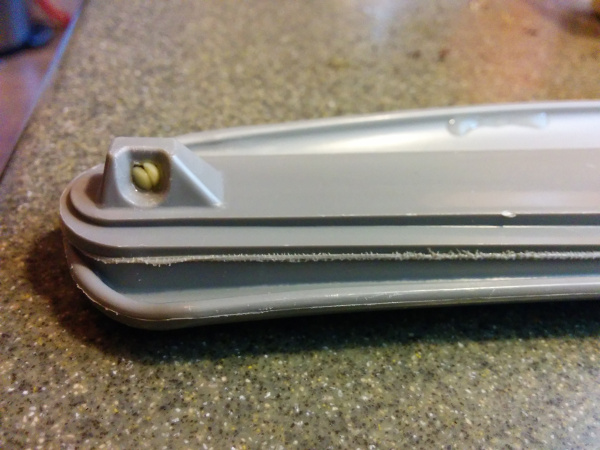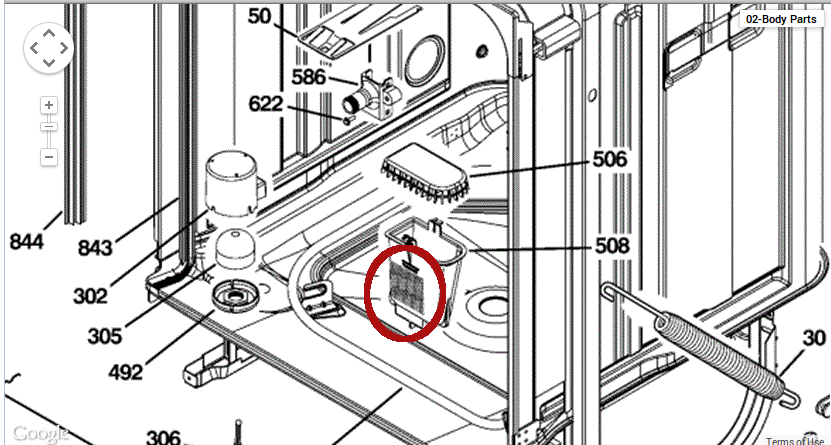Dish washer: Difference between revisions
| Line 2: | Line 2: | ||
====Symptom==== | ====Symptom==== | ||
The dish washer mostly works. However, it frequently will fail to wash the top rack. Furthermore, the dishes on both racks sometimes come out dirtier than when they went in. When this happens, I can take off the rotating arm that should spray the top rack from below and it will be clogged with food particles. The clog is generally at the end of the arm in the jet that should provide the force to spin the arm. | The dish washer mostly works. However, it frequently will fail to wash the top rack. Furthermore, the dishes on both racks sometimes come out dirtier than when they went in. When this happens, I can take off the rotating arm that should spray the top rack from below and it will be clogged with food particles. The clog is generally at the end of the arm in the jet that should provide the force to spin the arm. These clogs happen after almost every wash. | ||
[[File:clog.jpg]] | [[File:clog.jpg]] | ||
Revision as of 19:35, 29 November 2014
Dish washer troubleshooting
Symptom
The dish washer mostly works. However, it frequently will fail to wash the top rack. Furthermore, the dishes on both racks sometimes come out dirtier than when they went in. When this happens, I can take off the rotating arm that should spray the top rack from below and it will be clogged with food particles. The clog is generally at the end of the arm in the jet that should provide the force to spin the arm. These clogs happen after almost every wash.
With some effort the clog can be removed and the top rack will get cleaned again. But somewhere there is a place where the food chunks are not getting filtered.
I've tried to fix this before, and my first round of googling turned up the possible cause of broken glass in the bottom of the dish washer. And that was true. I cleaned out a bunch of broken glass. But that didn't fix the problem.
We've even called out a service tech and spent a bunch of money for him to clean the filter at the bottom (removing a bunch of paper stickers like the kind that are on fruit from the grocery store). But that didn't fix the problem.
Make and model
- Model: PDW9280J00SS
- Serial: VF821142B
Parts
Sears Parts has diagrams and parts lists online: http://www.searspartsdirect.com/partsdirect/part-model/GE-Parts/Dishwasher-Parts/Model-PDW9280J00SS/0432/0130000
Recall
A quick search shows that our model is part of a recall: http://www.cpsc.gov/en/Recalls/2011/GE-Recalls-Dishwashers-Due-to-Fire-Hazard/
Safety Recall GE Dishwashers - October 2010 Recall Your dishwasher is included in the recall. Based on the information you submitted, you have two options (please choose one): 1. Replace your dishwasher using a GE rebate offer. GE is offering a rebate on the purchase of a new dishwasher, $200 for GE Profile™ dishwashers and $400 for GE Monogram® dishwashers. You will need to mail in the rebate form along with the model tag off your current dishwasher and the receipt showing the purchase of the new dishwasher prior to receiving the rebate. Download rebate form 2. Schedule free repair service for your dishwasher.
Neither one of those steps is likely to help resolve the current symptom. Well, not unless we want to spend $1000. So the recall should be dealt with, but later.
Diagnostic resources
GE provides maintenance videos:
The closest video to our problem is "Poor wash due to blocked pump". However the video only demonstrates how to pull lettuce from the bottom of the dishwasher tub without any disassembly. That step only helped when I was removing broken glass from the bottom of the tub.
Theory #1
The GE video about poor wash performance indicated that parts 506 and 508 are resposible for pumping food particles out of the washer. If they are blocked, then food particles would be distributed around during the wash and not removed, which is one of the symptoms we have.
To test this, I reached in and scraped quite a bit of hair and fuzz from the screen that is part of 508.


